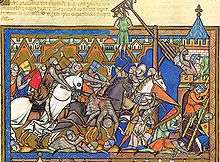Faussart
The Faussart is a long bladed two handed weapon, sometimes referred to as a Warbrand (by modern reproduction manufacturers). It is essentially a two handed falchion. It is different to a glaive in that a glaive is more like a halberd, and the Faussart is more like a sword. While the glaive has a lighter head and longer blade than a halberd, it has a shorter length blade than the Faussart. The Faussart could be used by both cavalry and infantry. It eventually evolved into the longsword.

Origins
The weapon probably relates to the agricultural tool for grass cutting, the Scythe The Maciejowski Bible (Morgan Bible) depicts an example of a two-handed Faussart used by a mounted knight. The weapon probably relates to the agricultural tool for grass cutting, the Scythe
Features
The Faussart had a straight, one-sided sharpened pointed blade, that was both slender and long. It carried a long handle for a two handed grip, which allowed a powerful blow from horseback. It also seems to have been light enough for one-hand handling, but could also be carried with two hands, so that it could be hefted with more strength, which was equally appropriate for mounted users and foot soldiers. The Warbrand in the Maciejowski Bible is shown without a guard, but it does not need it as a pure weapon.
General
There are no extant examples in existence of the Faussart, and no written descriptions of it, or manuals covering techniques for its use. The English term "Warbrand", used for this weapons is an erroneos modern fictional term invented by companies that sell modern reproductions, Warbrand simply meaning "War Sword".
Evolution/Development
The Faussart seems to have developed into the two handed long sword, or was made redundant by it, as there is no evidence that it continued to be used into the Late Medieval era when the longsword became commonplace.